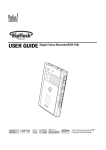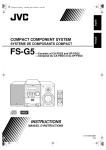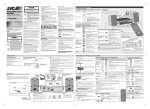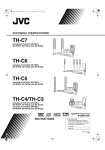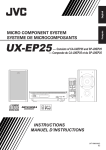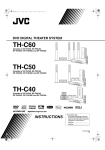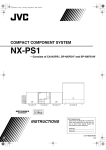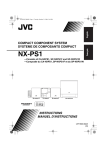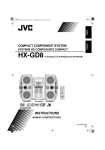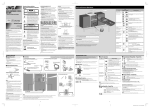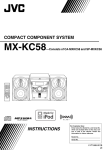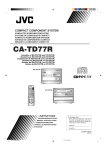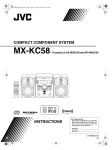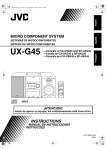Download JVC UX-G50 User's Manual
Transcript
Français English English COVERC.FM Page 1 Sunday, April 23, 2006 7:52 PM MICRO COMPONENT SYSTEM SYSTEME DE MICROCOMPOSANTS UX-G50 —Consists of CA-UXG50 and SP-UXG50 —Composée du CA-UXG50 et du SP-UXG50 INSTRUCTIONS MANUEL D’INSTRUCTIONS LVT1519-002B [C] UX-G50[C].BOOK Page 1 Friday, February 10, 2006 3:04 PM Warnings, Cautions and Others Mises en garde, précautions et indications diverses CAUTION RISK OF ELECTRIC SHOCK DO NOT OPEN CAUTION: TO REDUCE THE RISK OF ELECTRIC SHOCK, DO NOT REMOVE COVER (OR BACK). NO USER SERVICEABLE PARTS INSIDE. REFER SERVICING TO QUALIFIED SERVICE PERSONNEL. The lightning flash with arrowhead symbol, within an equilateral triangle is intended to alert the user to the presence of uninsulated "dangerous voltage" within the product's enclosure that may be of sufficient magnitude to constitute a risk of electric shock to persons. The exclamation point within an equilateral triangle is intended to alert the user to the presence of important operating and maintenance (servicing) instructions in the literature accompanying the appliance. WARNING: TO REDUCE THE RISK OF FIRE OR ELECTRIC SHOCK, DO NOT EXPOSE THIS APPLIANCE TO RAIN OR MOISTURE. For U.S.A. This equipment has been tested and found to comply with the limits for a Class B digital device, pursuant to part 15 of the FCC Rules. These limits are designed to provide reasonable protection against harmful interference in a residential installation. This equipment generates, uses and can radiate radio frequency energy and, if not installed and used in accordance with the instructions, may cause harmful interference to radio communications. However, there is no guarantee that interference will not occur in a particular installation. If this equipment does cause harmful interference to radio or television reception, which can be determined by turning the equipment off and on, the user is encouraged to try to correct the interference by one or more of the following measures: Reorient or relocate the receiving antenna. Increase the separation between the equipment and receiver. Connect the equipment into an outlet on a circuit different from that to which the receiver is connected. Consult the dealer or an experienced radio/TV technician for help. CAUTION Changes or modifications not approved by JVC could void the user’s authority to operate the equipment. G-1 UX-G50[C].BOOK Page 2 Friday, February 10, 2006 3:04 PM For the main unit: Note to CATV system installer: Declaration of Conformity This reminder is provided to call the CATV system installer’s attention to section 820-40 of the NEC which provides guidelines for proper grounding and, in particular, specifies that the cable ground shall be connected to the grounding system of the building, as close to the point of cable entry as practical. Model Number: Trade Name: Responsible Party: Address: UX-G50 JVC JVC Americas Corp. 1700 Valley Road, Wayne New Jersey 07470 Telephone Number: 973-317-5000 For Canada/pour le Canada This device complies with Part 15 of FCC Rules. Operation is subject to the following two conditions: (1) This device may not cause harmful interference, and (2) this device must accept any interference received, including interference that may cause undesired operation. THIS DIGITAL APPARATUS DOES NOT EXCEED THE CLASS B LIMITS FOR RADIO NOISE EMISSIONS FROM DIGITAL APPARATUS AS SET OUT IN THE INTERFERENCE-CAUSING EQUIPMENT STANDARD ENTITLED “DIGITAL APPARATUS,” ICES-003 OF THE DEPARTMENT OF COMMUNICATIONS. CET APPAREIL NUMERIQUE RESPECTE LES LIMITES DE BRUITS RADIOELECTRIQUES APPLICABLES AUX APPAREILS NUMIRIQUES DE CLASSE B PRESCRITES DANS LA NORME SUR LE MATERIEL BROUILLEUR; “APPAREILS NUMERIQUES”, NMB-003 EDICTEE PAR LE MINISTRE DES COMMUNICATIONS. Caution: Proper Ventilation To avoid risk of electric shock and fire, and to prevent damage, locate the apparatus as follows: 1. Front: No obstructions and open spacing. 2. Sides/ Top/ Back: No obstructions should be placed in the areas shown by the dimensions below. 3. Bottom: Place on the level surface. Maintain an adequate air path for ventilation by placing on a stand with a height of 10 cm (3-15/16") or more. Attention: Aération correcte Pour prévenir tout risque de décharge électrique ou d’incendie et éviter toute détérioration, installez l’appareil de la manière suivante: 1. Avant: Bien dégagé de tout objet. 2. Côtés/dessus/dessous: Assurez-vous que rien ne bloque les espaces indiqués sur le schéma ci-dessous. 3. Dessous: Posez l’appareil sur une surface plane et horizontale. Veillez à ce que sa ventilation correcte puisse se faire en le plaçant sur un support d’au moins dix centimètres de hauteur. Front Face 15 cm 1 cm 15 cm Side Côté 1 cm 15 cm 15 cm 15 cm 10 cm SP-UXG50 CA-UXG50 SP-UXG50 CA-UXG50 * About the cooling fan A cooling fan is mounted on the rear panel of the unit to prevent abnormal temperature inside the unit, thus assuring normal operation of the unit. The cooling fan automatically starts rotating to intake external cool air when the volume is increased up to more than a certain level. * À propos du ventilateur de refroidissement Un ventilateur de refroidissement se trouve sur le panneau arrière de l’appareil afin d’éviter la création d’une température anormale à l’intérieur de l’appareil et permettre ainsi un fonctionnement normal de l’appareil. Le ventilateur de refroidissement commence à tourner et à aspirer de l’air frais automatiquement quand le volume est augmenté au-dessus d’un certain niveau. G-2 UX-G50[C].BOOK Page 3 Friday, February 10, 2006 3:04 PM IMPORTANT FOR LASER PRODUCTS / IMPORTANT POUR PRODUITS LASER 1. CLASS 1 LASER PRODUCT 2. CAUTION: Do not open the top cover. There are no user serviceable parts inside the unit; leave all servicing to qualified service personnel. 3. CAUTION: VISIBLE AND / OR INVISIBLE CLASS 1M LASER RADIATION WHEN OPEN. DO NOT STARE INTO BEAM OR VIEW DIRECTLY WITH OPTICAL INSTRUMENTS. 4. REPRODUCTION OF LABEL: CAUTION LABEL, PLACED INSIDE THE UNIT. 1. PRODUIT LASER CLASSE 1 2. ATTENTION: N'ouvrez pas le couvercle supérieur. Il n'y a aucune pièce réparable par l'utilisateur à l'intérieur de l'appareil; confiez toute réparation à un personnel qualifié. 3. ATTENTION: RAYONNEMENT LASER VISIBLE ET / OU INVISIBLE DE CLASSE 1M UNE FOIS OUVERT. NE PAS FIXER LE FAISCEAU NI REGARDER DIRECTEMENT AVEC DES INSTRUMENTS OPTIQUES. 4. REPRODUCTION DE L'ÉTIQUETTE: ÉTIQUETTE DE PRÉCAUTION PLACÉE À L'INTERIEUR DE L'APPAREIL. G-3 UX-G50[C].BOOK Page 1 Tuesday, March 7, 2006 11:17 PM English Contents Introduction .....................................................2 Precautions ......................................................................2 How to Read This Manual ..............................................3 Getting Started ................................................ 4 Step 1: Unpack ................................................................4 Step 2: Prepare the Remote Control ...............................4 Step 3: Hook Up .............................................................5 Before Operating the System ......................... 8 Daily Operations—Playback ..........................9 Listening to the Radio ...................................................10 Playing Back a Disc ......................................................11 Playing Back from the PC ............................................13 Playing Back from other equipment .............................14 Quick Portable Link (QP Link) ....................................14 Daily Operations —Sound & Other Adjustments ................ 15 Adjusting the Volume ...................................................15 Adjusting the Sound .....................................................15 Changing the Display Brightness—DIMMER .............16 Setting the Clock ..........................................................16 Turning Off the Power Automatically ..........................17 Advanced Disc Operations ........................... 18 Programming the Playing Order—Program Play .........18 Playing at Random—Random Play ..............................19 Playing Repeatedly—Repeat Play ................................20 Prohibiting Disc Ejection—Child Lock .......................20 Timer Operations .......................................... 21 Setting the Timer ..........................................................21 Additional Information ................................ 23 Learning More about This System ...............................23 Troubleshooting ............................................................24 Maintenance ..................................................................24 Specifications ................................................................25 Parts Index ....................................................................25 1 UX-G50[C].BOOK Page 2 Tuesday, March 7, 2006 11:17 PM Thank you for purchasing the JVC Micro Component System. We hope it will be a valued addition to your home, giving you years of enjoyment. Be sure to read this instruction manual carefully before operating your new stereo system. In it you will find all the information you need to set up and use the system. If you have a query that is not answered by the manual, please contact your dealer. English Introduction Internal heat • A cooling fan is mounted on the rear panel to prevent heat buildup inside the main unit (see page G-2). For safety, observe the following carefully: • Make sure there is good ventilation around the main unit. Poor ventilation could overheat and damage the System. • DO NOT block the cooling fan and the ventilation openings or holes. If they are blocked by a newspaper or cloth, etc., the heat may not be able to get out. Precautions Installation Others • Install in a place which is level, dry and neither too hot nor too cold—between 5°C and 35°C. • Install the System in a location with adequate ventilation to prevent internal heat buildup inside the System. • Should any metallic object or liquid fall into the System, unplug the AC power cord and consult your dealer before operating any further. DO NOT install the System in a location near heat sources, or in a place subject to direct sunlight, excessive dust or vibration. • Leave sufficient distance between the System and the TV. • Keep the speakers away from the TV to avoid interference with TV. DO NOT disassemble the System since there are no user serviceable parts inside. • If you are not going to operate the System for an extended period of time, unplug the AC power cord from the wall outlet. If anything goes wrong, unplug the AC power cord and consult your dealer. Power sources • When unplugging the System from the wall outlet, always pull on the plug, not the AC power cord. DO NOT handle the AC power cord with wet hands. Moisture condensation Moisture may condense on the lenses inside the System in the following cases: • After starting to heat the room • In a damp room • If the System is brought directly from a cold to a warm place Should this occur, the System may malfunction. In this case, leave the System turned on for a few hours until the moisture evaporates, unplug the AC power cord, then plug it in again. 2 English UX-G50[C].BOOK Page 3 Tuesday, March 7, 2006 11:17 PM How to Read This Manual To make this manual as simple and easy-to-understand as possible, we have adapted the following methods: • Button and control operations are explained as listed in the table below. In this manual, the operations using the remote control is mainly explained; however, you can use the buttons and controls on the main unit if they have the same (or similar) name and marks. • Some related tips and notes are explained later in the sections “Learning More about This System” and “Troubleshooting,” but not in the same section explaining the operations. If you want to know more about the functions, or if you have a doubt about the functions, go to these sections and you will find the answers. Indicates that you press the button briefly. Indicates that you press the button briefly and repeatedly until an option you want is selected. Indicates that you press one of the buttons. 2 sec. Indicates that you press and hold the button for specified seconds. • The number inside the arrow indicates the period of press (in this example, 2 seconds). • If no number is inside the arrow, press and hold until the entire procedure is complete or until you get a result you want. Indicates that you turn the control toward the specified direction(s). Remote ONLY Main Unit ONLY 3 Indicates that this operation is only possible using the remote control. Indicates that this operation is only possible using the buttons and controls on the main unit. UX-G50[C].BOOK Page 4 Tuesday, March 7, 2006 11:17 PM Step 1:Unpack the package and check the accessories. English Getting Started Step 1: Unpack After unpacking, check to be sure that you have all the following items. The number in parentheses indicates the quantity of each piece supplied. • FM antenna (1) • AM loop antenna (1) • Remote control (1) • Batteries (2) If any item is missing, consult your dealer immediately. Step 2: Prepare the Remote Control Insert the batteries into the remote control by matching the polarity (+ and –) correctly. 1 Step 2: Prepare the remote control. 2 R6(SUM-3)/AA(15F) Step 3: Hook up the components such as AM/FM antennas, speakers, etc. (see pages 5 to 7). AM LOO P 3 AM EXT GND Finally plug the AC power cord. • DO NOT use an old battery together with a new one. • DO NOT use different types of batteries together. • DO NOT expose batteries to heat or flame. • DO NOT leave the batteries in the battery compartment when you are not going to use the remote control for an extended period of time. Otherwise, the remote control will be damaged from battery leakage. Now you can operate the System. 4 English UX-G50[C].BOOK Page 5 Tuesday, March 7, 2006 11:17 PM Step 3: Hook Up If you need more detailed information, see page 7. For more detailed information on connecting external equipment, see pages 13 and 14. Illustrations of the input/output terminals below are typical examples. When you connect other components, refer also to their manuals since the terminal names actually printed on the rear may vary. Turn the power off to all components before connections. For better FM/AM reception AM loop antenna Keep it connected. Outdoor FM antenna (not supplied) AM LOO P AM EXT Vynile-covered wire (not supplied) Extend it horizontally. GND Disconnect the supplied FM antenna, and connect to an outdoor FM antenna using a 75 Ω wire with coaxial type connector. To a wall outlet Plug the AC power cord only after all connections are complete. 5 English UX-G50[C].BOOK Page 6 Tuesday, March 7, 2006 11:17 PM FM antenna (supplied) Extend it so that you can obtain the best reception. AM loop antenna (supplied) Turn it until the best reception is obtained. AM LOOP AM EXT GND Black stripe Non-stripe 6 English UX-G50[C].BOOK Page 7 Tuesday, March 7, 2006 11:17 PM To assemble and connect the AM loop antenna To assemble the AM loop antenna To connect the AM loop antenna Make sure to connect the wire correctly. 1 Hold 2 Insert 3 Release • If the AM loop antenna wire or speaker cords are covered with vinyl, remove the vinyl to expose the tip of the antenna by twisting the vinyl. • Make sure the antenna conductors do not touch any other terminals, connecting cords and power cord. Also, keep the antennas away from metallic parts of the System, connecting cords, and the AC power cord. This could cause poor reception. To connect the speaker cords Make sure the both speakers are connected correctly and firmly. 3 Release 1 Hold 2 Insert When connecting the speaker cords, match the polarity of the speaker terminals: The cord with black stripe to (–), the cord without stripe to (+). • DO NOT connect more than one speaker to each terminal. • DO NOT allow the conductor of the speaker cords to be in touch with the metallic parts of the System. 7 UX-G50[C].BOOK Page 8 Tuesday, March 7, 2006 11:17 PM English Before Operating the System The indications on the display teach you a lot of things while you are operating the System. Before operating the System, be familiar with when and how the indicator illuminates on the display. 1 2 3 4 7 5 8 6 10 9 Indications on the main display • While listening to radio: • While selecting USB: Band Frequency • While playing a CD: Track number Source name • While selecting AUX: Elapsed playing time • While playing an MP3*: Current track number Elapsed playing time • While disc play is stopped: When RESUME is ON, RESUME is shown on the display. CD: Total track number Total playing time MP3: Total track number Total group number 1 Disc tray indicators • 1–5: Disc tray number • : Tray indicator – Lights when the disc is detected. – Blinking while playing back a disc. – Goes off when there is no disc in the tray. • : Shows the current disc. 2 QP Link Indicator • Lights when QP Link is activated. 3 MP3 indicator • Lights when an MP3 disc is detected. 4 FM reception indicators • MONO: Lights while the FM monaural mode is activated. • ST (stereo): Lights while an FM stereo station with sufficient signal strength is tuned in. 5 SOUND TURBO indicator • Lights when the SOUND TURBO is activated (see page 15). 6 A.STBY(Auto Standby) indicator • Lights when Auto Standby is activated. • Flashes when disc playback stops with Auto Standby activated. 7 Play mode indicators • RAND (random): Lights when Random Play mode is activated. • PRGM (program): Lights when Program Play mode is activated. • : Lights when Repeat mode is activated. – 1: Repeats the one track. – CD: Repeats the one disc – ALL: Repeats all the discs. – GR: Repeats all the tracks in the selected group. 8 Main display 9 AHB PRO (Active Hyper Bass Pro) indicator • Lights when the AHB PRO is activated. p Timer indicators • : Lights when Daily Timer stands by; flashes while working. • 1/2/3: Lights when a Daily Timer (1, 2, or 3) stands by; flashes while setting or working. • SLEEP: Lights when the Sleep Timer is activated. Total track number * When you start playing an MP3 disc, the group number, track number, track name, (and ID3 Tag) will be shown before the elapsed playing time appears. 8 UX-G50[C].BOOK Page 9 Tuesday, March 7, 2006 11:17 PM English Daily Operations—Playback 1 Turn on the power. 1 Numeric buttons SET/ RESUME MP3 MODE PRESET UP, PRESET DOWN 4/1, 7,¡/¢ 2 Disc selection buttons QP LINK FM MODE DIMMER 3 The STANDBY lamp on the main unit turns off. • Without pressing STANDBY/ON , the System turns on by pressing one of the source selecting buttons in the next step. 2 Select the source. Playback automatically starts if the selected source is ready to start. • If you press AUX or USB, start playback source on the external component. 3 Adjust the volume. 4 Operate the target source as explained later. To turn off (stand by) the System STANDBY/ON 1 The STANDBY lamp on the main unit lights up. • A small amount of power is always consumed even while on standby. STANDBY/ON To turn off the clock indication to save the power Remote ONLY While the System is turned off... DIMMER • Press the button again, to display the clock indication. 2 For private listening Connect a pair of headphones to the PHONES jack on the main unit. The sound will no longer come out of the speakers. Be sure to turn down the volume before connecting or putting the headphones. • Disconnecting the headphones will activate the speakers again. 3 VOLUME 4 9 DO NOT turn off (stand by) the System with the volume set to an extremely high level; otherwise, the sudden blast of sound can damage your hearing, speakers and/or headphones when you turn on the System or start playback. Listening to the Radio To preset the stations To select the band (FM or AM) You can preset 30 FM and 15 AM stations. FM English UX-G50[C].BOOK Page 10 Tuesday, March 7, 2006 11:17 PM Remote ONLY 1 Tune in to a station you want to preset. 2 Activate the preset number entry mode. AM SET/RESUME To tune in to a station While FM or AM is selected... Remote control: Main unit: 3 1 sec. 1 sec. DOWN UP Frequency starts changing on the display. When a station (frequency) with sufficient signal strength is tuned in, the frequency stops changing. • When you repeatedly press the button, the frequency changes step by step. To stop searching manually, press either button. If the received FM station is hard to listen FM MODE Remote ONLY The MONO indicator lights on the display. Reception will improve though stereo effect is lost—Monaural reception mode. To restore the stereo effect, press the button again (the MONO indicator goes off). 4 • Finish the following process while the indication on the display is flashing. Select a preset number for the station you store. 1 2 3 4 5 6 7 8 9 0 10 Examples: To select preset number 5, press 5. To select preset number 15, press > = 10 → 1 → 5. To select preset number 30, press > = 10 → 3 → 0. • You can also use the PRESET UP/PRESET DOWN buttons. Store the station. SET/RESUME memo • If you preset a station set to MONO, the station is stored with the MONO setting. 10 English UX-G50[C].BOOK Page 11 Tuesday, March 7, 2006 11:17 PM To tune in to a preset station Remote ONLY 1 Select a band (FM or AM). FM AM 2 Select a preset number for the station you store. 1 2 3 4 5 6 7 8 9 0 10 To select a disc to be played back CD 1 CD 2 CD 4 CD 5 To start: CD 3 To pause: To release, press again. To select a track/group* Increases the track/group* numbers. This System can play back the following discs—regular CD and CD-R/CD-RW (recorded either in the audio CD or MP3 format). Disc Type Mark (logo) Decreases the track/group* numbers. * For details about the group selection, see “For MP3 playback” on page 12. To locate a particular portion Audio CD While playing a disc, press and hold until the portion you want is reached. CD-R CD-RW Fast-forwards the track. • Caution for DualDisc playback The Non-DVD side of a “DualDisc” does not comply with the “Compact Disc Digital Audio” standard. Therefore, the use of Non-DVD side of a DualDisc on this product may not be recommended. Fast-reverses the track. * No sound is played during this operation on MP3 discs. To locate a track directly and start play Main Unit ONLY 1 2 3 4 5 6 7 8 9 0 10 You can insert discs while playing another source. To close the disc tray, press the same 0 again. • When the current disc tray is open, pressing CD 6 closes the tray and the playback starts. • When you press 0 for the next tray you want to place another disc onto, the first disc tray automatically closes and then the next tray comes out. 11 To stop: • You can also use the PRESET UP or PRESET DOWN. Playing Back a Disc To insert a disc • The same operation can be carried out using CD1 to CD5 on the system. Remote ONLY Examples: To select track number 5, press 5. To select track number 15, press > 10 → 1 → 5. = To select track number 30, press > = 10 → 3 → 0. (For MP3 discs with 100 or more tracks) To select track number 125, press > = 10 twice → 1 → 2 → 5. * For up to 99 tracks, you can > 10 twice to turn to the press = condition before > = 10 is pressed. English UX-G50[C].BOOK Page 12 Tuesday, March 7, 2006 11:17 PM Resume Play for Audio CD/MP3 For MP3 playback If you press 7 during playback, the position of the track where you stopped playback will be memorized by the unit. By pressing CD 6, you can start playback again from the point where you stoppped it. According to the MP3 playback mode, 4/1 / ¡/¢ or number buttons work for the group selection or the track selection. To activate/cancel resume play Remote ONLY Examples: When the MP3 play back mode is “GROUP.” GR (Group) indicator When the source is a CD... 2 sec. SET/RESUME RESUME ON RESUME OFF memo • Changing the disc by pressing the disc selection buttons will erase the track number for resume play. • To play back from the first track while resume play is activated, press 7 twice during playback then press CD 6. Total group number Total track number You can change the MP3 playback mode by pressing MP3 MODE. • Each time you press the button, the MP3 playback mode changes as follows: TRACK MP3 MODE GROUP TRACK: 4/1, ¡/¢ , and number buttons work for the track selection of the MP3 discs. GROUP: 4/1, ¡/¢ , and number buttons work for the group selection of the MP3 discs. Number buttons works for selecting the track number within the group. MP3 groups/tracks configuration This System plays back MP3 tracks as follows. Hierarchy Level 1 Level 2 Level 3 Level 4 01 03 04 ROOT 01 1 4 1 5 2 6 9 7 3 02 Level 5 10 8 05 11 12 Group with its play order MP3 track with its play order 12 English UX-G50[C].BOOK Page 13 Sunday, April 23, 2006 6:20 PM To play back sounds on the PC Playing Back from the PC This System is equipped with a USB terminal on the front panel of the main unit. You can connect your PC to this terminal and enjoy sound reproduced through your PC. When you connect your PC for the first time, follow the procedure below. • Remember you cannot send any signal or data to your PC from this System. Press USB, then start playback from PC. Refer to the manuals supplied with the sound reproduction application installed in the PC. * MicrosoftR, WindowsR 98, WindowsR 98SE, WindowsR Me, WindowsR 2000 and WindowsR XP are registered trademarks of Microsoft corporation. memo How to install the USB drivers 1 Turn on your PC and start running WindowsR 98, 2 3 4 WindowsR 98SE, WindowsR Me, WindowsR 2000, or WindowsR XP. • If the PC has been turned on, quit all the applications now running. Select USB as the source. Set the volume to minimum. Connect the System to the PC using a USB cable (not supplied). (front panel) PC USB cable • Use “USB series A plug to B plug” cable when connecting. IMPORTANT • Always set volume to “VOL-MIN” when connecting or disconnecting the other equipment. 5 The USB drivers are installed automatically. 13 • DO NOT turn off the unit or disconnect the USB cable while installing the drivers and for several seconds while your PC is recognizing the receiver. • Use a full speed USB cable (version 1.1). Recommended cord length is shorter than approximately 2 m. • If your PC does not recognize the unit, disconnect the USB cable and connect it again. If it does not work yet, restart Windows. • The installed drivers can be recognized only when the USB cable is connected between the unit and your PC. • The sound may not be played back correctly—interrupted or degraded—due to your PC settings and PC specifications. English UX-G50[C].BOOK Page 14 Tuesday, March 7, 2006 11:17 PM Playing Back from other equipment Quick Portable Link (QP Link) To connect other equipment If you connect other equipment such as a digital audio player to the AUX terminal and play it back, the source automatically changes to AUX. By using an stereo mini plug cord (not supplied), you can connect equipment with analog audio output jacks such as a Digital Audio Player, or a TV, etc. QP LINK Stereo mini plug cord (not supplied) Remote ONLY QP Link Canceled Portable audio device, Game machine, etc. AUX (front panel) If the audio output on the other equipment is not stereo mini plug type, Use a plug adapter to convert the stereo mini plug to the corresponding plug of the audio output. Refer to the manuals supplied with the other equipment. IMPORTANT • Always set volume to “VOL-MIN” when connecting or disconnecting the other equipment. To adjust the sound input level from other equipment You can adjust the sound input level from the connected equipment, if the incoming signal is too small or too large. 1 Select AUX for the source. 2 Adjust the input level. 2 sec. SET/RESUME AUX LVL 1 AUX LVL 2 AUX LVL 1: Ordinary input level (factory setting). Suitable for equipment with low output level (such as a portable audio device). AUX LVL 2: Decreased input level. Suitable for equipment with high output level (such as a DVD player). (No indication) The QP Link indicator is lit while QP Link is activated. When QP Link is activated... • If an audio input is received at AUX when the System is turned on, the source automatically switches to AUX. • If an audio input is received at AUX when the System is in standby mode, the system automatically turns on and plays the audio. • You cannot change the source while audio input is being received at AUX. If you press another source button, the QP Link indicator blinks several times. memo • While playback is going on the portable audio device, QP Link may turn the System on even if the Sleep Timer turn the System to standby or if you turn the System to standby. In this case, deactivate QP Link or stop playback on the device connected to the AUX jack. • If the audio input received at AUX is small, the source may not switch to AUX. • The source may not switch to AUX depending on the content of the music. • It takes a second or two for the source to switch to AUX after another equipment such as a digital audio player is started and sound is output. This is due to the System detecting the signal from the equipment. • QP Link does not work, if the clock indication is turned off at standby. memo • If you feel that the output level from the external equipment is high, select AUX LVL2. 14 UX-G50[C].BOOK Page 15 Tuesday, March 7, 2006 11:17 PM English Daily Operations—Sound & Other Adjustments Adjusting the Volume Remote control You can adjust the volume level from level 0 (VOL-MIN) to level 31 (VOL-MAX). Remote control: Main unit: VOLUME SET/RESUME CANCEL CLOCK/ TIMER 4/1, 7,¡/¢ VOLUME DISPLAY PRESET UP, PRESET DOWN To drop the volume in a moment Remote ONLY To restore the volume, press again, or adjust the volume level. FADE MUTING DIMMER A.STANDBY SLEEP SOUND TURBO AHB PRO FADE MUTING VOLUME +/– BASS/ TREBLE Adjusting the Sound To emphasize the sound—SOUND TURBO This function emphasizes the sound. SOUND TURBO S-TURBO OFF (Canceled) To reinforce the bass sound —AHB PRO Main unit Remote ONLY You can reinforce the bass sound to maintain rich, full bass at low volume. AHB PRO AHB PRO OFF (Canceled) SOUND TURBO VOLUME +/– To adjust the tone—BASS/TREBLE Remote ONLY You can adjust the bass and treble level from 0 to +5. To adjust the bass BASS/ TREBLE BASS TREBLE Canceled VOLUME To adjust the treble BASS/ TREBLE BASS TREBLE Canceled VOLUME When SOUND TURBO is ON, BASS/TREBLE is disabled. 15 English UX-G50[C].BOOK Page 16 Tuesday, March 7, 2006 11:17 PM Changing the Display Brightness —DIMMER Remote ONLY You can dim the display window. DIMMER DIM ON DIM OFF (Canceled) Setting the Clock Remote ONLY Without setting the built-in clock, you cannot use the Daily Timer (see page 21). • To exit from the clock setting, press CLOCK/TIMER as required. • To go back to the previous step, press CANCEL. 1 Activate the clock setting mode. CLOCK /TIMER 2 • If you have already adjusted the clock before, press the button repeatedly until the clock setting mode (see page 21) is selected. Adjust the hour. PRESET UP SET/RESUME PRESET DOWN 3 Adjust the minute. PRESET UP SET/RESUME PRESET DOWN “CLOCK OK” appears and the built-in clock starts working. To check the current time during play DISPLAY Clock Source information If there is a power failure The clock loses the setting and is reset to “AM 12:00.” You need to set the clock again. 16 English UX-G50[C].BOOK Page 17 Tuesday, March 7, 2006 11:17 PM Turning Off the Power Automatically Remote ONLY To turn off the System after playback is over— Auto Standby This function works only when the source is CD. A.STANDBY A.STBY Canceled (No indication) When Auto Standby is in use, the A.STBY indicator lights on the display. When the disc playback stops, the A.STBY indicator starts flashing. If no disc operation is done for about 3 minutes while the indicator is flashing, the System turns off (stands by) automatically. To turn off the System after a certain period of time—Sleep Timer 1 Specify the time (in minutes). SLEEP 10 20 30 60 90 120 OFF (Canceled) 2 Wait until the set time goes off. To check the time remaining until the shut-off time SLEEP • If you press the button repeatedly, you can change the shutoff time. 17 UX-G50[C].BOOK Page 18 Tuesday, March 7, 2006 11:17 PM English Advanced Disc Operations Programming the Playing Order— Remote control Remote ONLY Program Play You can arrange the playing order of the tracks (up to 32) before you start playback. • You cannot enjoy MP3 discs for program play. • You can repeat all the programmed tracks by pressing REPEAT. Numeric buttons CANCEL 1 Before starting playback, press PROGRAM. PROGRAM 4/1, 7,¡/¢ CD 6 Disc selection buttons REPEAT RANDOM 2 3 Select a disc by pressing CD 1–CD 5. Select tracks you want for Program Play. PROGRAM Disc number Main unit 4 5 1 2 3 4 5 6 7 8 9 0 10 Program step Examples: To select track number 5, press 5. To select track number 15, press > = 10 → 1 → 5. To select track number 30, press > = 10 → 3 → 0. Repeat steps 2 and 3 to program the other tracks. • To select a track from the same disc, repeat step 3. Start playback. The tracks you have selected are played back in the order you have programmed. CD 1 0 7 Track number To skip a track: To pause: To stop: To release, press again. • Tracks cannot be selected with the Numeric buttons during Program Play. 18 English UX-G50[C].BOOK Page 19 Tuesday, March 7, 2006 11:17 PM To check the programmed contents While the PRGM indicator is shown on the display and before playback... In the programmed order. In the reverse order. Playing at Random—Random Play Remote ONLY You can play back all the tracks on the selected disc at random. • You can repeat the current disc by pressing REPEAT. 1 2 Select a disc by pressing CD 1 – CD 5. Press RANDOM. RANDOM To modify the program While the PRGM indicator is shown on the display and before playback... To erase the last step: To erase the entire program: Playback starts in random order. Random Play ends when all tracks are played. To skip a track: To pause: To stop: CANCEL To add steps in the program: Repeat steps 2 and 3 on page 18. To exit from Program Play While the PRGM indicator is shown on the display... PROGRAM To release, press again. • Tracks cannot be selected with the Numeric buttons during Random Play. To exit from Random Play While the RAND indicator is shown on the display... RANDOM Pressing 7 also cancels Program Play. • During the PRGM indicator is shown on the display, you cannot open the disc trays. 19 Remote ONLY Playing Repeatedly—Repeat Play You can repeat playback. Main Unit ONLY You can lock the disc trays so that no one can eject the loaded discs. • This is possible while the System is on standby. For CD/MP3 (TRACK mode): REPEAT Prohibiting Disc Ejection—Child Lock 1 CD Canceled While the disc trays are closed... ALL (No indication) CD1 For MP3 (GROUP mode): REPEAT GR 1 Canceled CD ALL (No indication) (at the same time) • Only CD 1 0 can work for this function. To cancel the prohibition, repeat the same procedure. “UNLOCKED” appears on the display. During Program Play: REPEAT Canceled (No indication) During Random Play: REPEAT CD Canceled (No indication) 1 CD GR ALL Repeats the current track. Repeats all the tracks on the current disc. (Selectable in Normal play and Random play) Repeats all the tracks in the current group (for MP3 playback mode in “GROUP” only). Repeats all the discs. Repeats the program. 20 English UX-G50[C].BOOK Page 20 Tuesday, March 7, 2006 11:17 PM UX-G50[C].BOOK Page 21 Tuesday, March 7, 2006 11:17 PM English Timer Operations Setting the Timer Remote control STANDBY/ON CLOCK/ TIMER SET/RESUME CANCEL Remote ONLY Using Daily Timer, you can wake up with music, etc. • You can store three Daily Timer settings; however, you can activate only one of Daily Timers at the same time. • To exit from the timer setting, press CLOCK/TIMER as required. • To correct a misentry during the process, press CANCEL. You can return to the previous step. How Daily Timer actually works PRESET UP, PRESET DOWN Once the Daily Timer has been set, the timer ( ) indicator and timer number indicator (1, 2, or 3) are lit on the display. Daily Timer is activated at the same time everyday until the timer is turned off manually or another Daily Timer is activated. When the on-time comes The System turns on, tunes in to the selected station or start playing the selected disc, and sets the volume level to the preset level. • If “P – – –” is selected, the last tuned station is selected. • If “VOL – –” is selected, the last specified value is selected. • While Daily Timer is working, the timer ( ) and timer number indicators (1, 2, or 3) flash on the display. • The timer setting remains in memory until you change it. • Without canceling the Daily Timer, you can change the source or adjust the volume after Daily Timer starts playback. 1 Select one of the timer setting modes you want to set— Daily 1 Timer, Daily 2 Timer, or Daily 3 Timer. CLOCK /TIMER Daily 1 Timer Daily 2 Timer Canceled Daily 3 Timer Clock setting (see page 16) Ex.: When Daily Timer 1 setting mode is selected 21 2 Make the timer setting as you want. 1 Set the hour then the minute for on-time. PRESET UP English UX-G50[C].BOOK Page 22 Tuesday, March 7, 2006 11:17 PM To turn off the Timer after its setting is done Since Daily Timer is activated at the same time everyday, you may need to cancel it on some particular days. SET/RESUME 1 Select the Timer you want to cancel. PRESET DOWN CLOCK /TIMER 2 Set the hour then the minute for off-time in the same manner. 3 Select the playback source—“TUNER FM,” “TUNER AM,” “DISC,” or “AUX.” PRESET UP Daily 1 Timer Daily 2 Timer Canceled Daily 3 Timer Clock setting (see page 16) 2 Turn off the selected Timer. CANCEL SET/RESUME PRESET DOWN The number indicator corresponding to the Daily Timer is turned off. To turn on the Timer again, repeat the above steps and press in step 2... SET/RESUME When selecting tuner: Select a preset number or “P – – –” by pressing PRESET UP or PRESET DOWN, then press SET. When selecting CD: Select a disc by pressing PRESET UP or PRESET DOWN, then press SET. 4 Set the volume. The number indicator corresponding to the Daily Timer lights. PRESET UP SET/RESUME PRESET DOWN 3 If you select “VOL – –,” the volume is set to the level that was set before the power was turned off. Turn off the System (on standby) if you have set the timer with the System turned on. STANDBY/ON 22 English UX-G50[C].BOOK Page 23 Tuesday, March 7, 2006 11:17 PM Additional Information Learning More about This System Daily Operations—Playback (see pages 9 to 14) Listening to the Radio: • If you store a new station into an occupied preset number, the previously stored station in that number will be erased. • When you unplug the AC power cord or if a power failure occurs, the preset stations will be erased in a few days. If this happens, preset the stations again. Playing Back a Disc: • When using an 8 cm disc, place it on the inner circle of the disc tray. • This System cannot play “packet write” discs. • For MP3 playback... – MP3 discs are required a longer readout time than regular CDs. (It depends on the complexity of the group/file configuration.) – Some MP3 files cannot be played back and will be skipped. This result from their recording processes and conditions. – When making MP3 discs, use ISO 9660 Level 1 or Level 2 for the disc format. – This System can play back MP3 files with the extension code <.mp3> (regardless of the letter case—upper/lower). – Some characters or symbols will not be shown correctly on the display. The maximum character number shown on the display is 32 (without the extension code) for files, and 30 for ID3 tag. – It is recommended that you make each MP3 file at a sampling rate of 44.1 kHz and at bit rate of 128 kbps. – This System can recognize the total of 500 tracks and of 200 groups. Those exceeding the maximum number cannot be recognized. – Playback order of MP3 tracks may be different from the one you have intended while recording. If a folder does not include MP3 tracks, they are ignored. When discs* in more than one tray are loaded on the disc trays, they are played in sequence as follows: Ex.: When CD 2 is selected: CD 2 -> CD 3 -> CD 4 -> CD 5 -> CD 1 (then selects CD 2, and stops) * When no disc is loaded on the tray, that disc number is skipped. You can exchange discs while playing or selecting another disc. Daily Operations—Sound & Other Adjustments (see pages 15 to 17) Adjusting the Volume: • Be sure to turn down the volume before connecting or putting the headphones. Adjusting the Sound: • This function also affects the sound through the headphones. Setting the Clock: • “AM12:00” will flash on the display until you set the clock. • The clock may gain or lose 1 to 2 minutes per month. If this happens, reset the clock. Turning the Power Automatically: • Auto Standby cannot be canceled by the following operations. – Changing the display brightness. – Adjusting the volume. – Adjusting the sound. Advanced Disc Operations (see pages 18 to 20) Programming the Playing Order—Program Play: • If you try to program a 33rd track, “FULL” appears on the display. • While programming steps... Your entry will be ignored if you have tried to program an item number that does not exist on the disc (for example, selecting track 14 on a disc that only has 12 tracks). Timer Operations (see pages 21 and 22) • When you unplug the AC power cord or if a power failure occurs, the timer will be canceled. You need to set the clock first, then the timer again. • If you set the Sleep Timer after Daily Timer starts playing the selected source, Daily Timer is canceled. Other The following settings are memorized by the system for two or three days even if the AC power cord is removed. The settings are reset to factory default values after few days in which case you must set them again. Preset stations, volume, BASS/TREBLE, AHB PRO, SOUDN TURBO, AUX LEVEL, QP Link, and timer. To remove the speaker grilles Quick Portable Link (QP Link) • The system holds the On/Off status of QP Link even when the AC power cord is connected or removed. • The source remains at AUX when you stop the other equipment such as a digital audio player. Speaker grille Holes 23 Projections Troubleshooting If you are having a problem with your System, check this list for a possible solution before calling for service. Disc Operations: The disc does not play. ] The disc is placed upside down. Place the disc with the label side up. General: The disc sound is discontinuous. Adjustments or settings are suddenly canceled before you finish. ] There is a time limit. Repeat the procedure again. Operations are disabled. The disc tray does not open or close. ] The built-in microprocessor may malfunction due to external electrical interference. Unplug the AC power cord and then plug it back in. Unable to operate the System from the remote control. ] The path between the remote control and the remote sensor on the System is blocked. ] Point it at the remote sensor on the font panel. ] Signals cannot reach the remote sensor. More closer to the System. ] The batteries are exhausted. English UX-G50[C].BOOK Page 24 Sunday, April 23, 2006 6:20 PM ] The disc is scratched or dirty. ] The AC power cord is not plugged in. ] Child Lock is in use (see page 20). Timer Operations: Daily Timer does not work. ] The System has been turned on when the on-time comes. Timer starts working only when the System is turned off. Maintenance To get the best performance of the System, keep your discs, and mechanism clean. Handling discs • When removing the disc from its case, hold it at the edge while pressing the center hole lightly. • Do not touch the shiny surface of the disc, or bend the disc. • Put the disc back in its case after use to prevent warping. • Be careful not to scratch the surface of the disc. • Avoid exposure to direct sunlight, temperature extremes, and moisture. To clean the disc: Wipe the disc with a soft cloth in a straight line from center to edge. Cleaning the System No sound is heard from the speakers. ] Speaker connections are incorrect or loose (see page 7). ] Headphones are connected (see page 9). Sound from PC connected with a USB cable has some noise (see page 13). ] PC is subjected to excessive load due to using other applications. Close the applications you do not use. ] PC is connected via USB Hub. Connect the PC directly to the main unit with a USB cable. System does not turn off. ] QP Link is active (see page 14). Radio Operations: • Stains should be wiped off with a soft cloth. If the System is heavily stained, wipe it with a cloth soaked in water-diluted neutral detergent and wrung well, then wipe clean with a dry cloth. • Since the System may deteriorate in quality, it become damaged or get its paint peeled off, be careful about the following: – DO NOT wipe it with a hard cloth. – DO NOT wipe it strongly. – DO NOT wipe it with thinner or benzine. – DO NOT apply any volatile substance such as insecticides to it. – DO NOT allow any rubber or plastic to remain in contact for a long time. Hard to listen to broadcasts because of noise (see pages 4 to 7). ] Antennas connections are incorrect or loose. ] The AM loop antenna is too close to the System. ] The FM antenna is not properly extended and positioned. 24 Specifications Parts Index Amplifier section Refer to the pages to see how to use the buttons and controls. Output Power: 120 W per channel, min. RMS, driven into 6 Ω at 1 kHz with no more than 10% total harmonic distortion. Speakers Impedance: 6 Ω – 16 Ω Audio Input AUX Input sensitivity/Impedance: LEVEL1: 150 mV/47 kΩ LEVEL2: 500 mV/47 kΩ USB: USB Ver. 1.1 Remote control Tuner section FM tuning range: AM tuning range: 87.5 MHz – 108.0 MHz 530 kHz – 1 710 kHz STANDBY/ON CD player section Dynamic range: 85 dB Signal-to-noise ratio: 85 dB Wow and flutter: Immeasurable 1 2 3 4 5 6 10, 11, 18 CANCEL 7 Power requirement: Power consumption: AC 120 V , 60 Hz 155 W (at operation) 20 W (at standby) 0.8 W (at on standby and Display off) Dimensions (approx.): 175 mm × 246 mm × 415 mm (W/H/D) Mass (approx.): 7.4 kg Speakers Type: 2-way Bass reflex Speaker units: Woofer: 12 cm cone × 1 Tweeter: 4 cm cone × 1 Impedance: 6Ω Dimensions (approx.): 145 mm × 246 mm × 212 mm (W/H/D) Mass (approx.): 2.2 kg each Supplied Accessories See page 4. Design and specification are subject to change without notice. 25 9 8 DISPLAY 0 General 9, 22 SET/RESUME MP3 MODE IIV English UX-G50[C].BOOK Page 25 Tuesday, March 7, 2006 11:17 PM 10 CLOCK /TIMER PRESET UP 12 10-12, 18 PRESET DOWN 10, 12, 14, 16, 22 19, 22 9, 16 16, 21, 22 10, 11, 16, 22 11, 18, 19 10-12, 18, 19 10, 11, 16, 22 9-11, 13, 18, 19 11, 18, 19 20 18, 19 17 CD 1 CD 2 CD 4 CD 5 CD 3 FM MODE REPEAT PROGRAM RANDOM SLEEP A.STANDBY DIMMER SOUND TURBO AHB PRO QP LINK FADE MUTING 14 10 15 19 9, 15 BASS/ TREBLE 15 17 15 VOLUME REMOTE CONTROL 16 15 English UX-G50[C].BOOK Page 26 Tuesday, March 7, 2006 11:17 PM Main unit Remote sensor 9, 22 11, 20 8 9, 11, 13 9, 15 15 10–12, 20 13 9 14 26 UX-G50[C].BOOK Page 1 Wednesday, March 8, 2006 12:24 AM Table des matières Introduction .....................................................2 Précautions ......................................................................2 Comment lire ce manuel .................................................3 Pour démarrer .................................................4 Français Étape 1: Déballage ..........................................................4 Étape 2: Préparation de la télécommande .......................4 Étape 3: Connexions .......................................................5 Avant d’utiliser la chaîne ...............................8 Opérations quotidiennes—Lecture ............... 9 Écoute de la radio .........................................................10 Lecture d’un disque ......................................................11 Lecture à partir de l’ordinateur .....................................13 Lecture à partir d’un autre appareil ..............................14 Quick Portable Link (QP Link) ....................................14 Opérations quotidiennes— Ajustement du son et autres ajustements .... 15 Ajustement du volume ..................................................15 Ajustement du son ........................................................15 Modification de la luminosité de l’affichage —DIMMER ....16 Réglage de l’horloge .....................................................16 Mise hors tension de l’appareil automatiquement ........17 Opérations avancées des disques ................. 18 Programmation de l’ordre de lecture— Lecture programmée .................................................18 Lecture dans un ordre aléatoire—Lecture aléatoire.......19 Répétition de la lecture —Lecture répétée ...................20 Interdiction de l’éjection du disque —Verrou parental .....20 Utilisation de la minuterie ............................ 21 Réglage de la minuterie ................................................21 Informations additionnelles ......................... 23 Pour en savoir plus sur cette chaîne ..............................23 Guide de dépannage ......................................................24 Entretien ........................................................................24 Spécifications ................................................................25 Nomenclature ................................................................25 1 UX-G50[C].BOOK Page 2 Wednesday, March 8, 2006 12:24 AM Introduction Échauffement interne • Un ventilateur de refroidissement est monté sur le panneau arrière pour éviter tout échauffement interne de l’appareil principal (voir page G-2). Pour votre sécurité, respectez les points suivants attentivement: • Assurez-vous qu’il y a une ventilation suffisante autour de l’appareil principal. Une mauvaise ventilation peut entraîner un échauffement et endommager la chaîne. • NE BLOQUEZ PAS le ventilateur de refroidissement ni les ouvertures et trous de ventilation. S’ils sont bloqués par un journal, un tissu, etc., la chaleur ne pourra peut-être pas être évacuée de l’appareil. Précautions Installation • Installez la chaîne dans un endroit plat, sec, et ni trop chaud, ni trop froid—entre 5°C et 35°C. • Installez la chaîne dans un endroit avec une bonne ventilation pour éviter tout échauffement intérieur de l’appareil. N’INSTALLEZ PAS la chaîne dans en endroit proche d’une source de chaleur ou sujet à la lumière directe du soleil, à un poussière excessive ou à des vibrations. • Laissez suffisamment d’espace entre la chaîne et le téléviseur. • Éloignez les enceintes du téléviseur pour éviter toute interférence avec ce dernier. Sources d’alimentations • Pour débrancher la chaîne de la prise murale, tirez toujours sur la fiche et non pas sur le cordon d’alimentation secteur. Français Nous vous remercions d’avoir choisi le système de composants micro JVC. Nous espérons que ce produit vous satisfera pleinement, et ce pendant des années. Veuillez lire attentivement ce manuel d’instructions avant d’utiliser votre nouvelle chaîne stéréo. Toutes les informations nécessaires à son installation et à son utilisation sont fournies. Si vous avez une question dont la réponse ne figure pas dans le manuel, contactez votre revendeur. Autres • Si un objet métallique ou un liquide tombait à l’intérieur de la chaîne, débranchez le cordon d’alimentation secteur et consultez votre revendeur avant d’utiliser l’appareil à nouveau. NE DÉMONTEZ PAS la chaîne. Il n’y a aucune pièce réparable par l’utilisateur à l’intérieur. • Si vous n’avez pas l’intention d’utiliser la chaîne pendant une période prolongée, débranchez le cordon d’alimentation secteur de la prise murale. En cas de problème, débranchez le cordon d’alimentation secteur et consultez votre revendeur. NE MANIPULEZ PAS le cordon d’alimentation secteur avec les mains mouillées. Condensation d’humidité De la condensation peut se produire sur les lentilles à l’intérieur de la chaîne dans les cas suivants: • Après le démarrage d’un chauffage dans la pièce • Dans une pièce humide • Si la chaîne est amenée directement d’un endroit froid vers un endroit chaud Si cela se produit, la chaîne risque de ne pas fonctionner correctement. Dans ce cas, laissez-la sous tension pendant quelques heures jusqu’à ce que l’humidité se soit évaporées, puis débranchez le cordon d’alimentation secteur puis rebranchez-le. 2 UX-G50[C].BOOK Page 3 Wednesday, March 8, 2006 12:24 AM Français Comment lire ce manuel Pour rendre ce manuel aussi simple et facile à comprendre que possible, nous avons adopté les méthodes suivantes: • Les opérations des touches et des commandes sont expliquées dans le tableau ci-dessous. Dans ce manuel, nous expliquons principalement les opérations à l’aide de la télécommande ; cependant, vous pouvez utiliser les touches et les commandes de l’appareil si elles portent le même nom (ou un nom similaire) et la même marque. • Certains conseils et remarques associées sont expliqués plus tard dans les sections “Pour en savoir plus sur cette chaîne” et “Guide de dépannage”, mais pas dans la section expliquant les opérations. Si vous souhaitez avoir plus d’informations à propos des fonctions, ou si vous vous posez des questions, allez à ces sections et vous trouverez les réponses. Indique que vous devez appuyer sur la touche brièvement. Indique que vous devez appuyer sur la touche brièvement et répétitivement jusqu’à ce que l’option souhaitée soit choisie. Indique que vous devez appuyer sur une des touches. 2 sec. Indique que vous maintenez pressée la touche pendant le nombre de secondes indiqué. • Le nombre à l’intérieur de la flèche indique la période pendant laquelle vous devez maintenir la touche pressée (2 secondes, dans cet exemple). • Si aucun nombre n’est indiqué dans la flèche, maintenez la touche pressée jusqu’à la fin de la procédure ou jusqu’à ce que vous obteniez le résultat souhaité. Indique que vous devez tourner la commande dans la ou les directions spécifiées. Remote ONLY Main Unit ONLY 3 Indique que cette opération est possible uniquement en utilisant la télécommande. Indique que cette opération est possible uniquement en utilisant les touches et les commandes de l’appareil. UX-G50[C].BOOK Page 4 Wednesday, March 8, 2006 12:24 AM Pour démarrer accessoires. Étape 1: Déballage Après le déballage, vérifiez que tous les éléments suivants sont présents. Le nombre entre parenthèse indique la quantité de chaque pièce fournie. • Antenne FM (1) • Antenne cadre AM (1) • Télécommande (1) • Piles (2) Si quelque chose manquait, consultez votre revendeur immédiatement. Étape 2: Préparation de la télécommande Insérez les piles dans la télécommande en respectant les polarités (+ et –). 1 Étape 2: Préparation de la télécommande. 2 R6(SUM-3)/AA(15F) Étape 3: Connexion des composants tels que les antennes AM/FM, les enceintes etc. (voir pages 5 à 7). AM LOO P 3 AM EXT GND Finalement, branchez le cordon d’alimentation. Maintenant, vous pouvez utiliser la chaîne. • N’UTILISEZ PAS une vielle pile avec une pile neuve. • N’UTILISEZ PAS ensemble deux types différents de pile. • N’EXPOSEZ PAS les piles à la chaleur ou à une flamme. • NE LAISSEZ PAS les piles dans le compartiment à piles si vous n’avez pas l’intention d’utiliser la télécommande pendant une longue période de temps. Sinon, les piles pourraient fuir et endommager la télécommande. 4 Français Étape 1: Déballage et vérification des UX-G50[C].BOOK Page 5 Wednesday, March 8, 2006 12:24 AM Étape 3: Connexions Si vous avez besoin d’informations plus détaillées, voir page 7. Pour des informations plus détaillées sur la connexion de l’appareil externe, voir les pages 13 et 14. Français Les illustrations des prises d’entrée/sortie ci-dessous sont des exemples typiques. Quand vous connectez d’autres appareils, référez-vous aussi à leurs modes d’emploi car le nom des prises imprimé au dos de l’appareil peut varier. Mettez tous les appareils hors tension avant les connexions. Pour une meilleure réception FM/AM Antenne cadre AM Gardez-la connectée. Antenne FM extérieure (non fournie) AM LOO P AM EXT Fil recouvert de vinyle (non fourni) Étendez-le horizontalement. GND Déconnectez l’antenne FM fournie et connectez l’appareil à une antenne FM extérieure en utilisant un connecteur de type coaxial 75 Ω . À une prise murale Branchez le cordon d’alimentation secteur uniquement après que toutes les connexions sont terminées. 5 Français UX-G50[C].BOOK Page 6 Wednesday, March 8, 2006 12:24 AM Antenne FM (fournie) Étendez-la de façon à obtenir la meilleure réception possible. Antenne cadre AM (fournie) Tournez-la jusqu’a que vous obteniez la meilleure réception possible. AM LOOP AM EXT GND Bande noire Sans bande 6 UX-G50[C].BOOK Page 7 Wednesday, March 8, 2006 12:24 AM Pour assembler et connecter l’antenne cadre AM Pour assembler l’antenne cadre AM Pour connecter l’antenne cadre AM Assurez-vous de connecter le fil correctement. Français 1 Maintenez 2 Insérez 3 Relâchez • Si les fils de l’antenne cadre AM ou des cordons d’enceinte sont recouverts de vinyle, retirez-le pour mettre à nu l’âme de l’antenne en torsadant la partie en vinyle. • Assurez-vous que les conducteurs d’antenne ne touchent aucunes autres prises, cordons de connexion ou cordon d’alimentation. De plus, gardez les antennes à l’écart des parties métalliques de la chaîne, des cordons de connexion et du cordon d’alimentation secteur. Cela pourrait entraîner une mauvaise réception. Pour connecter les cordons d’enceinte Assurez-vous que les deux enceintes sont connectées correctement et solidement. 3 Relâchez 1 Maintenez 2 Insérez Lors de la connexion des cordons d’enceinte, respectez les polarités des prises d’enceinte: Le cordon à bande noire à (–), le cordon sans bande à (+). • NE CONNECTEZ PAS plus d’une enceinte à chaque prise. • NE laissez pas les conducteurs des cordons d’enceinte toucher les parties métalliques de la chaîne. 7 UX-G50[C].BOOK Page 8 Wednesday, March 8, 2006 12:24 AM Avant d’utiliser la chaîne 1 2 3 7 4 5 8 6 10 9 Indications sur l’affichage principal • Lors de l’écoute de la radio: • Quand USB est choisie: Bande Fréquence Nom de la source • Lors de la lecture d’un CD: • Quand AUX est choisi: Numéro de plage Durée de lecture écoulée • Lors de la lecture d’un disque MP3*: Numéro de la plage actuelle Durée de lecture écoulée • Quand la lecture du disque est arrêtée: Si RESUME est activé, RESUME apparaît sur l’affichage. CD: Nombre total de plages Durée de lecture totale MP3: Nombre total de plages Nb total de groupes 1 Indicateurs de plateau à disque • 1–5: Numéro de plateau à disque • : Indicateur de plateau – S’allume quand un disque est détecté. – Clignote lors de la lecture d’un disque. – S’éteint quand il n’y a pas de disque sur le plateau. • : Montre le disque actuel. 2 Indicateur QP Link • S’allume quand QP Link est en service. 3 Indicateur MP3 • S’allume quand un disque MP3 est détecté. 4 Indicateurs de réception FM • MONO: S’allume quand le mode FM monaural est en service. • ST (stéréo): S’allume lorsqu’une station FM stéréo de signal suffisamment fort est accordée. 5 Indicateur SOUND TURBO • S’allume quand la fonction SOUND TURBO est en service (voir page 15). 6 Indicateur A.STBY (mise en attente automatique) • S’allume quand la mise en attente automatique est en service. • Clignote quand la lecture d’un disque est arrêtée par la mise en attente automatique. 7 Indicateurs de mode de lecture • RAND (aléatoire): S’allume quand le mode de lecture aléatoire est en service. • PRGM (programme): S’allume quand le mode de lecture programmée est en service. • : S’allume quand le mode de répétition est en service. – 1: Répète une seule plage. – CD: Répète tout le disque – ALL: Répète tous les disques. – GR: Répète toutes les plages du groupe choisi. 8 Affichage principal 9 Indicateur AHB PRO (Active Hyper Bass Pro) • S’allume quand la fonction AHB PRO est en service. p Indicateurs de minuterie • : S’allume quand la minuterie quotidienne est en attente; clignote pendant son fonctionnement. • 1/2/3: Ils s’allument quand la minuterie quotidienne (1, 2, or 3) est en attente et clignotent quand elle est en cours de réglage ou en cours de fonctionnement. • SLEEP: S’allume quand la minuterie d’arrêt est en service. Nombre total de plages * Quand vous démarrez la lecture d’un disque MP3, le numéro de groupe, le numéro de plage, le nom de la plage (et la balise ID3) apparaissent avant la durée de lecture écoulée. 8 Français Les indications sur l’affichage vous donnent beaucoup d’informations pendant l’utilisation de la chaîne. Avant d’utiliser la chaîne, familiarisez-vous avec les indicateurs, et en particulier, quand et comment ils s’allument sur l’affichage. UX-G50[C].BOOK Page 9 Wednesday, March 8, 2006 12:24 AM Opérations quotidiennes—Lecture 1 Mise sous tension de l’appareil. 1 Français Touches numériques SET/ RESUME MP3 MODE PRESET UP, PRESET DOWN 4/1, 7,¡/¢ 2 Touches de sélection de disque QP LINK FM MODE DIMMER 3 Le témoin STANDBY s’éteint sur l’appareil. • Sans appuyer sur STANDBY/ON , la chaîne se met sous tension quand vous appuyez sur une des touches de sélection de source à l’étape suivante. 2 Sélection de la source. La lecture automatique démarre si la source choisie est prête. • Si vous appuyez sur AUX ou USB, démarrez la source de lecture sur l’appareil extérieur. 3 Ajustez le volume. 4 Commandez l’appareil source comme expliqué ci-après. Pour mettre la chaîne hors tension (en attente) STANDBY/ON 1 Le témoin STANDBY s’allume sur l’appareil. • Une petite quantité d’énergie est toujours consommée, même en mode d’attente. STANDBY/ON Pour mettre hors service l’indication de l’horloge afin d’économiser de l’électricité Remote ONLY Pendant que la chaîne est hors tension... DIMMER 2 • Appuyez de nouveau sur la touche pour afficher l’indication de l’horloge. Pour une écoute privée Connectez un casque d’écoute à la prise PHONES sur l’appareil. Plus aucun son ne sort des enceintes. Assurezvous de réduire le volume avant de connecter un casque ou de vous le mettre sur les oreilles. • Déconnecter le casque d’écoute met à nouveau en service les enceintes. 3 VOLUME 4 9 NE METTEZ PAS la chaîne hors tension (en attente) quand son niveau de volume est réglé extrêmement haut; sinon la déflagration soudaine du son pourrait endommager les enceintes et/ou le casque d’écoute lors de la mise sous tension de la chaîne ou de la lecture. UX-G50[C].BOOK Page 10 Wednesday, March 8, 2006 12:24 AM Écoute de la radio Pour prérégler les stations Pour choisir la bande (FM ou AM) Vous pouvez préréglez 30 stations FM et 15 stations AM. 1 Accordez la station que vous souhaitez prérégler. 2 Mettez en service le mode d’entrée de numéro de AM Français FM Remote ONLY préréglage. SET/RESUME Pour accorder une station Quand FM ou AM est choisi... Télécommande: Appareil: 1 sec. 3 1 sec. DOWN UP La fréquence change sur l’affichage. Quand une station (fréquence) avec un signal suffisamment fort est accordée, la fréquence s’arrête de changer. • Si vous appuyez répétitivement sur la touche, la fréquence change pas à pas. Pour arrêter la recherche manuelle, appuyez sur n’importe quelle touche. Si la station reçue est difficile à écouter FM MODE Remote ONLY L’indicateur MONO s’allume sur l’affichage. La réception est améliorée mais l’effet stéréo est perdu—mode de réception monophonique. Pour rétablir l’effet stéréo, appuyez de nouveau sur la touche (l’indicateur MONO s’éteint). 4 • Terminez la procédure suivante pendant que l’indication clignote sur l’affichage. Choisissez un numéro de préréglage pour la station à mémoriser. 1 2 3 4 5 6 7 8 9 0 10 Exemples: Pour choisir le numéro de préréglage 5, appuyez sur 5. Pour choisir le numéro de préréglage 15, appuyez sur > = 10 → 1 → 5. Pour choisir le numéro de > 10 préréglage 30, appuyez sur = → 3 → 0. • Vous pouvez aussi utiliser les touches PRESET UP/ PRESET DOWN. Mémorisez la station. SET/RESUME memo • Si vous préréglez une station définie sur MONO, elle sera mémorisée avec le réglage MONO. 10 UX-G50[C].BOOK Page 11 Wednesday, March 8, 2006 12:24 AM Pour accorder une station préréglée Remote ONLY 1 Choisissez une bande (FM ou AM). Français FM AM 2 Choisissez un numéro de préréglage pour la station à Pour choisir le disque à reproduire CD 1 CD 2 CD 4 CD 5 CD 3 • La même opération peut être effectuée à l’aide des touches CD1 à CD5 sur la chaîne. Pour démarrer: Pour faire une pause: Pour arrêter: mémoriser. 1 2 3 4 5 6 7 8 9 0 10 • Vous pouvez aussi utiliser les touches PRESET UP ou PRESET DOWN. Pour reprendre la lecture, appuyez de nouveau sur la touche. Pour choisir une plage/groupe* Lecture d’un disque Augmente le numéro de plage/groupe*. Cette chaîne peut reproduire les disques suivants—CD ordinaire et CD-R/CD-RW (enregistré au format CD audio ou MP3). Diminue le numéro de plage/groupe*. Type de disque Marque (logo) CD audio * Pour les détails à propos de la sélection des groupes, référez-vous à “Pour la lecture MP3...” à la page 12. Pour localiser un passage particulier Lors de la lecture d’un disque, maintenez la touche pressée jusqu’à ce que la position souhaitée soit atteinte. CD-R CD-RW Avance rapide de la plage • Précautions pour la lecture de disques à double face La face non DVD d’un disque à “DualDisc” n’est pas compatible avec le standard “Compact Disc Digital Audio”. Par conséquent, l’utilisation de la face non DVD d’un disque à double face sur cet appareil n’est pas recommandée. Pour insérer un disque Main Unit ONLY Vous pouvez insérer des disques lors de la lecture d’une autre source. Pour fermer le plateau à disque, appuyez de nouveau sur la même touche 0. • Quand le plateau à disque actuel est ouvert, appuyer sur CD 6 referme le plateau et démarre la lecture. • Quand vous appuyez sur 0 pour le plateau suivant sur lequel vous souhaitez placer un autre disque, le premier plateau à disque se ferme automatiquement et le plateau suivant s’ouvre. 11 Retour rapide de la plage * Aucun son n’est émis lors de cette opération sur des disques MP3. Pour localiser une plage directement et démarrer la lecture 1 2 3 4 5 6 7 8 9 0 10 Remote ONLY Exemples: Pour choisir le numéro de plage 5, appuyez sur 5. Pour choisir le numéro de plage 15, > 10 → 1 → 5. appuyez sur = Pour choisir le numéro de plage 30, appuyez sur > = 10 → 3 → 0. (Pour les disques MP3 avec au moins 100 plages) Pour choisir le numéro de plage 125, appuyez sur > = 10 deux fois → 1 → 2 → 5. * Pour les plages jusqu’à 99, vous pouvez appuyer sur > = 10 deux fois pour revenir à l’état avant la pression sur > = 10. UX-G50[C].BOOK Page 12 Wednesday, March 8, 2006 12:24 AM Reprendre la lecture d’un CD audio/MP3 Pour la lecture MP3... Si vous appuyez sur 7 pendant la lecture, l’endroit de la plage où vous avez arrêté la lecture est mémorisé par la chaîne. En appuyant sur CD 6, vous pouvez redémarrer la lecture à l’endroit où vous l’avez arrêtée. Selon le mode de lecture MP3, 4/1 / ¡/¢ ou les touches numériques fonctionnent pour la sélection de groupe ou de plage. Français Pour activer/annuler la reprise de la lecture Exemples: Quand le mode de lecture MP3 est “GROUP”. Indicateur GR (groupe) Remote ONLY Quand la source est un CD... 2 sec. SET/RESUME RESUME ON RESUME OFF Nb total de groupes Nombre total de plages Vous pouvez changer le mode de lecture MP3 en appuyant sur MP3 MODE. • Chaque fois que vous appuyez sur la touche, le mode de lecture MP3 change comme suit: MP3 MODE memo • Le changement de disque par pression sur les touches de sélection de disque efface le numéro de plage pour la reprise de la lecture. • Pour reprendre la lecture à partir de la première plage quand la reprise de la lecture est activée, appuyez sur 7 deux fois pendant la lecture, puis appuyez sur CD 6. TRACK GROUP TRACK: 4/1, ¡/¢, et les touches numériques fonctionnent pour la sélection de plage des disques MP3. GROUP: 4/1, ¡/¢, et les touches numériques fonctionnent pour la sélection de groupe des disques MP3. Les touches numériques fonctionnent pour la sélection du numéro de plage dans le groupe. Configuration des groupes/plages MP3 Cette chaîne reproduit les plages MP3 de la façon suivante. 01 03 ROOT 01 1 7 3 02 9 04 4 1 5 2 6 10 8 05 11 12 Groupe avec son ordre de lecture Plage MP3 avec son ordre de lecture 12 BASIC.FM Page 13 Thursday, April 27, 2006 1:05 AM Français Lecture à partir de l’ordinateur Cette chaîne est munie d’une prise USB sur le panneau avant de l’appareil principal. Vous pouvez connecter votre ordinateur à cette prise et écouter les sons reproduits par votre ordinateur. Pour connecter votre ordinateur pour la première fois, suivez la procédure ci-dessous. • Notez que vous ne pouvez envoyer aucun signal ou donnée sur votre ordinateur à partir de cette chaîne. Pour reproduire le son de l’ordinateur. Appuyez sur USB, puis démarrez la lecture sur l’ordinateur. Référez-vous aux modes d’emploi fournis avec le logiciel de reproduction du son installé sur l’ordinateur. * MicrosoftR, WindowsR 98, WindowsR 98SE, WindowsR Me, WindowsR 2000 et WindowsR XP sont des marques déposées de Microsoft corporation. memo Comment installer les pilotes USB 1 Mettez votre ordinateur sous tension et démarrez 2 3 4 WindowsR 98, WindowsR 98SE, WindowsR Me, WindowsR 2000, ou WindowsR XP. • Si l’ordinateur est déjà sous tension, quittez toutes les applications en cours d’exécution. Choisissez USB comme source. Réglez le volume au minimum. Connectez la chaîne à l’ordinateur en utilisant un câble USB (non fourni). (panneau avant) Ordinateur Câble USB • Utilisez un câble “USB fiche A-fiche B” pour la connexion. IMPORTANT • Réglez toujours le volume sur “VOL-MIN” lors de la connexion ou de la déconnexion de l’autre appareil. 5 Les pilotes USB sont installés automatiquement. 13 • NE METTEZ PAS cet appareil hors tension ni ne déconnectez le câble USB pendant l’installation des pilotes et aussi pendant les quelques secondes nécessaires à l’ordinateur pour reconnaître cet appareil. • Utilisez un câble USB plein débit (version 1.1). La longueur de câble recommandée doit être inférieure à 2 m environ. • Si votre ordinateur ne reconnaît pas l’appareil, déconnectez le câble USB puis reconnectez-le à nouveau. Si cela ne fonctionne toujours pas, redémarrez Windows. • Les pilotes installés peuvent être reconnus uniquement quand le câble USB est connecté entre cet appareil et votre ordinateur. • Le son peut ne pas être reproduit correctement— interrompu ou dégradé—à cause des réglages ou des spécifications de votre ordinateur. UX-G50[C].BOOK Page 14 Wednesday, March 8, 2006 12:24 AM Lecture à partir d’un autre appareil Quick Portable Link (QP Link) Connexion d’un autre appareil Si vous connectez un autre équipement tel qu’un lecteur audio numérique à la prise AUX et que vous commencez la lecture, la source passe automatiquement en AUX. QP LINK QP Link Français En utilisant un cordon à mini fiche stéréo (non fourni), vous pouvez connecter un appareil muni de prises de sortie audio analogique tel qu’un lecteur audio numérique ou un téléviseur, etc. Remote ONLY Annulé Cordon à mini fiche stéréo (non fourni) (Pas d’indication) Appareil audio portable, console de jeux, etc. AUX (panneau avant) Si la sortie audio de l’autre appareil n’est pas de type mini-fiche stéréo, Utilisez un adaptateur de fiche pour convertir la mini-fiche stéréo au format de la fiche correspondant à la sortie audio. Référez-vous aux modes d’emploi fourni avec l’autre appareil. IMPORTANT • Réglez toujours le volume sur “VOL-MIN” lors de la connexion ou de la déconnexion de l’autre appareil. Pour ajuster le niveau d’entrée de son d’un autre équipement Vous pouvez ajuster le niveau d’entrée de son d’un équipement connecté, si le signal d’entrée est trop faible ou trop important. 1 Choisissez AUX comme source. 2 Ajustez le niveau d’entrée. 2 sec. SET/RESUME AUX LVL 1 AUX LVL 2 AUX LVL 1: Niveau d’entrée normal (réglage d’usine). Convient pour l’équipement avec un bas niveau de sortie (tel qu’un appareil audio portable). AUX LVL 2: Niveau d’entrée diminué. Convient pour l’équipement avec un niveau de sortie élevé (tel qu’un lecteur de DVD). L’indicateur QP Link s’allume quand QP Link est en service. Quand QP Link n’est pas en service... • Si une entrée audio est reçue sur AUX quand la chaîne est sous tension, la source passe automatiquement en AUX. • Si une entrée audio est reçue sur AUX quand la chaîne est en attente, la chaîne se met automatiquement sous tension et reproduit le son. • Vous ne pouvez pas modifier la source quand une entrée audio est reçue sur AUX. Si vous appuyez sur une autre touche de source, l’indicateur QP Link clignote plusieurs fois. memo • Lors de la lecture sur l’appareil audio portable, QP Link peut mettre la chaîne sous tension même si la minuterie met la chaîne en attente ou si vous la mettez en attente. Dans pareil cas, désactivez QP Link ou arrêtez la lecture sur l’appareil connecté à la prise AUX. • Si l’entrée audio reçue sur AUX est faible, la source peut ne pas passer en AUX. • La source peut ne pas passer en AUX selon le contenu de la musique. • Le passage de la source en AUX et l’émission du son nécessitent une seconde ou deux après la mise en marche d’un autre équipement tel qu’un lecteur audio numérique. Cela est dû à la détection du signal par la chaîne à partir de l’équipement. • QP Link ne fonctionne pas si l’indication de l’horloge est mise hors service en attente. memo • Si vous avez l’impression que le niveau de sortie de l’équipement externe est élevé, choisissez AUX LVL2. 14 UX-G50[C].BOOK Page 15 Wednesday, March 8, 2006 12:24 AM Opérations quotidiennes—Ajustement du son et autres ajustements Ajustement du volume Télécommande Vous pouvez ajuster le niveau de volume du niveau 0 (VOLMIN) au niveau 31 (VOL-MAX). Télécommande: Appareil: Français VOLUME SET/RESUME CANCEL CLOCK/ TIMER 4/1, 7,¡/¢ VOLUME DISPLAY PRESET UP, PRESET DOWN Remote ONLY Pour couper le volume momentanément Pour rétablir le volume, appuyez de nouveau sur la touche ou ajuster le niveau de volume. FADE MUTING DIMMER A.STANDBY SLEEP SOUND TURBO AHB PRO FADE MUTING VOLUME +/– BASS/ TREBLE Ajustement du son Pour accentuer le son—SOUND TURBO Cette fonction accentue le son. SOUND TURBO S-TURBO OFF (Annulé) Pour renforcer les sons graves— AHB PRO Appareil Remote ONLY Vous pouvez renforcer les sons graves afin de conserver la richesse et la plénitude des graves à faible niveau de volume. AHB PRO AHB PRO OFF (Annulé) Pour ajuster la tonalité—BASS/TREBLE SOUND TURBO VOLUME +/– Remote ONLY Vous pouvez ajuster le niveau des graves et des aigus entre 0 et +5. Pour ajuster les graves BASS/ TREBLE BASS TREBLE Annulé VOLUME Pour ajuster les aigus BASS/ TREBLE BASS TREBLE Annulé VOLUME Quand SOUND TURBO est activé, BASS/TREBLE est désactivé. 15 UX-G50[C].BOOK Page 16 Wednesday, March 8, 2006 12:24 AM Modification de la luminosité de l’affichage —DIMMER Remote ONLY Vous pouvez réduire la luminosité de la fenêtre d’affichage. DIMMER Français DIM ON DIM OFF (Annulé) Réglage de l’horloge Remote ONLY Sans régler l’horloge intégrée, vous ne pouvez pas utiliser la minuterie quotidienne (voir page 21). • Pour quitter le réglage de l’horloge, appuyez sur CLOCK/ TIMER autant de fois que nécessaire. • Pour retourner à l’étape précédente, appuyez sur CANCEL. 1 Mettez en service le mode de réglage de l’horloge. CLOCK /TIMER 2 • Si vous avez déjà ajusté l’horloge précédemment, appuyez répétitivement sur la touche jusqu’à ce que le mode de réglage de l’horloge (voir page 21) soit choisi. Ajustez les heures. PRESET UP SET/RESUME PRESET DOWN 3 Ajustez les minutes. PRESET UP SET/RESUME PRESET DOWN “CLOCK OK” apparaît et l’horloge intégrée entre en service. Pour vérifier l’heure actuelle pendant la lecture DISPLAY Horloge Informations de la source Si une coupure de courant se produit Le réglage de l’horloge est perdu et réinitialisé à “AM 12:00.” Vous devez régler l’horloge à nouveau. 16 UX-G50[C].BOOK Page 17 Wednesday, March 8, 2006 12:24 AM Mise hors tension de l’appareil Français automatiquement Remote ONLY Pour mettre la chaîne hors tension une fois que la lecture est terminée—Mise en attente automatique Cette fonction ne marche que quand la source est CD. A.STANDBY A.STBY Annulé (Pas d’indication) Quand la mise en attente automatique est en service, l’indicateur A.STBY s’allume sur l’affichage. Quand la lecture du disque s’arrête, l’indicateur A.STBY clignote. Si aucune opération relative au disque n’est réalisée pendant environ 3 minutes alors que l’indicateur clignote, la chaîne se met automatiquement hors tension (en attente). Pour mettre la chaîne hors tension après une certaine période de temps—Minuterie d’arrêt 1 Spécifiez la durée (en minutes). SLEEP 10 20 30 60 90 120 OFF (Annulé) 2 Attendez que la durée réglée disparaisse. Pour vérifier la durée restante avant la mise hors tension SLEEP • Si vous appuyez répétitivement sur la touche, vous pouvez changer l’heure de mise hors tension. 17 UX-G50[C].BOOK Page 18 Wednesday, March 8, 2006 12:24 AM Opérations avancées des disques Programmation de l’ordre de lecture— Lecture programmée Remote ONLY Vous pouvez arranger l’ordre de lecture des plages (32 maximum) avant de démarrer la lecture. • Vous ne pouvez pas utiliser la lecture programmée pour les disques MP3. • Vous pouvez répéter toutes les plages programmées en appuyant sur REPEAT. Touches numériques CANCEL 1 Avant de démarrer la lecture, appuyez sur PROGRAM. PROGRAM 4/1, 7,¡/¢ CD 6 Touches de sélection de disque REPEAT 2 3 RANDOM Choisissez un disque en appuyant sur CD 1 – CD 5. Choisissez les plages que vous souhaitez pour la lecture programmée. PROGRAM Numéro de disque Numéro de plage 1 2 3 4 5 6 7 8 9 0 10 Appareil 4 5 Exemples: Pour choisir le numéro de plage 5, appuyez sur 5. Pour choisir le numéro de plage > 10 → 1 → 5. 15, appuyez sur = Pour choisir le numéro de plage 30, appuyez sur > = 10 → 3 → 0. Répétez les étapes 2 à 3 pour programmer d’autres plages. • Pour choisir une plage à partir du même disque, répétez l’étape 3. Démarrez la lecture. Les plages que vous avez choisies sont reproduites dans l’ordre que vous avez programmé. CD 1 0 7 Pas de programme Pour sauter une plage: Pour faire une pause: Pour arrêter: Pour reprendre la lecture, appuyez de nouveau sur la touche. • Il est impossible de choisir les plages avec les touches numériques pendant la lecture programmée. 18 Français Télécommande UX-G50[C].BOOK Page 19 Wednesday, March 8, 2006 12:24 AM Pour vérifier le contenu programmé Pendant que l’indicateur PRGM apparaît sur l’affichage et avant la lecture... Français Dans l’ordre programmé. Dans l’ordre inverse. Pour modifier le programme Pendant que l’indicateur PRGM apparaît sur l’affichage et avant la lecture... Pour effacer la dernière étape: Lecture dans un ordre aléatoire— Lecture aléatoire Remote ONLY Vous pouvez reproduire toutes les plages sur disque choisi de façon aléatoire. • Vous pouvez répéter le disque actuel en appuyant sur REPEAT. 1 2 Choisissez un disque en appuyant sur CD 1 – CD 5. Appuyez sur RANDOM. RANDOM Pour effacer tout le programme: CANCEL Pour ajouter des étapes au programme: Répétez les étapes 2 et 3 de la page 18. La lecture dans un ordre aléatoire démarre. La lecture aléatoire s’arrête lorsque toutes les plages ont été reproduites. Pour sauter une plage: Pour faire une pause: Pour arrêter: Pour quitter la lecture programmée Pendant que l’indicateur PRGM apparaît sur l’affichage... Pour reprendre la lecture, appuyez de nouveau sur la touche. PROGRAM Appuyer sur 7 annule aussi la lecture programmée. • Pendant que l'indicateur PRGM apparaît sur l'affichage, vous ne pouvez pas ouvrir les plateaux à disque. • Il est impossible de choisir les plages avec les touches numériques pendant la lecture aléatoire. Pour quitter la lecture aléatoire Pendant que l’indicateur RAND apparaît sur l’affichage... RANDOM 19 UX-G50[C].BOOK Page 20 Wednesday, March 8, 2006 12:24 AM Répétition de la lecture — Verrou parental Vous pouvez répéter la lecture. Vous pouvez verrouiller les plateaux à disque de façon que personne ne puisse éjecter le disque en place. • C’est possible quand la chaîne est en attente. Pour les CD/MP3 (Mode TRACK): REPEAT Main Unit ONLY 1 CD Annulé Quand les plateaux à disque sont fermés... ALL (Pas d’indication) CD1 Pour les MP3 (Mode GROUP): REPEAT GR 1 Annulé CD ALL (Pas d’indication) (en même temps) • Seul CD 1 0 peut être utilisé pour cette fonction. Pour annuler l’interdiction, répétez la même procédure. “UNLOCKED” apparaît sur l’affichage. Pendant la lecture programmée: REPEAT Annulé (Pas d’indication) Pendant la lecture aléatoire: REPEAT CD Annulé (Pas d’indication) 1 CD GR ALL Répète la plage actuelle. Répète toutes les plages du disque actuel (peut être choisi en lecture normale et en lecture aléatoire). Répète toutes les plages du groupe actuel (pour le mode de lecture MP3 “GROUP” uniquement). Répète tous les disques. Répète le programme. 20 Français Lecture répétée Interdiction de l’éjection du disque— Remote ONLY UX-G50[C].BOOK Page 21 Wednesday, March 8, 2006 12:24 AM Utilisation de la minuterie Réglage de la minuterie Français Télécommande STANDBY/ON CLOCK/ TIMER SET/RESUME CANCEL PRESET UP, PRESET DOWN Remote ONLY En utilisant la minuterie quotidienne, vous pouvez vous réveiller au son de musique, etc. • Vous pouvez mémoriser trois réglages de minuterie quotidienne; cependant, vous ne pouvez mettre en service qu’une seule de ces minuteries quotidiennes en même temps. • Pour quitter le réglage de la minuterie, appuyez sur CLOCK/TIMER autant de fois que nécessaire. • Pour corriger une mauvaise entrée pendant la procédure, appuyez sur CANCEL. Vous pouvez retourner à l’étape précédente. Fonctionnement de la minuterie quotidienne Une fois que la minuterie quotidienne a été réglée, l’indicateur de minuterie ( ) et l’indicateur de numéro de minuterie (1, 2 ou 3) s’allument sur l’affichage. La minuterie quotidienne est mise en service à la même heure tous les jours jusqu’à ce que la minuterie soit mise hors service manuellement ou qu’une autre minuterie quotidienne soit mise en service. Quand l’heure de mise en service arrive La chaîne se met sous tension, accorde la station choisie ou démarre la lecture du disque choisi, et règle le niveau de volume sur le niveau préréglé. • Si “P – – –” est choisi, la dernière station accordée est choisie. • Si “VOL – –” est choisi, la dernière valeur spécifiée est choisie. • Quand la minuterie quotidienne est en service, l’indicateur de minuterie ( ) et les indicateurs de numéro de minuterie (1, 2 ou 3) clignotent sur l’affichage. • Le réglage de la minuterie reste en mémoire tant qu’il n’est pas changé. • Sans annuler la minuterie quotidienne, vous pouvez changer la source ou ajuster le volume après le démarrage de la minuterie. 1 Choisissez le mode de réglage de la minuterie que vous souhaitez régler—Minuterie quotidienne 1, 2 ou 3. CLOCK /TIMER Daily 1 Timer Annulé Daily 2 Timer Daily 3 Timer Réglage de l’horloge (voir page 16) Ex.: Quand le mode de réglage de la minuterie quotidienne 1 est choisi 21 UX-G50[C].BOOK Page 22 Wednesday, March 8, 2006 12:24 AM Effectuez le réglage de la minuterie comme vous le souhaitez. 1 Réglez les heures puis les minutes de l’heure de mise en service. PRESET UP SET/RESUME Pour mettre la minuterie hors service une fois le réglage effectué Puisque la minuterie quotidienne se met en service à la même heure tous les jours, vous avez peut-être besoin de l’annuler certains jours. 1 Choisissez la minuterie que vous souhaitez annuler. PRESET DOWN CLOCK /TIMER 2 Réglez de la même manière les heures puis les minutes de l’heure de mise hors service. 3 Choisissez la source de lecture—“TUNER FM”, “TUNER AM”, “DISC”, ou “AUX”. PRESET UP Daily 1 Timer Annulé Daily 2 Timer Daily 3 Timer Réglage de l’horloge (voir page 16) 2 Mettez la minuterie choisie hors service. CANCEL SET/RESUME PRESET DOWN L’indicateur du numéro correspondant à la minuterie quotidienne s’éteint. Pour mettre la minuterie à nouveau en service, répétez les étapes ci-dessus et appuyez à l’étape 2... SET/RESUME Quand le tuner est choisi: Choisissez un numéro de préréglage ou “P – – –” en appuyant sur PRESET UP ou PRESET DOWN, puis appuyez sur SET. Quand CD est choisi: Choisissez un disque en appuyant sur PRESET UP ou PRESET DOWN, puis appuyez sur SET. 4 Réglez le volume. L’indicateur du numéro correspondant à la minuterie quotidienne s’allume. PRESET UP SET/RESUME PRESET DOWN 3 Si vous choisissez “VOL – –,” le volume est réglé sur le niveau défini avant la mise hors tension de la chaîne. Mettez la chaîne hors tension (en attente) si vous avez réglez la minuterie avec la chaîne sous tension. STANDBY/ON 22 Français 2 UX-G50[C].BOOK Page 23 Wednesday, March 8, 2006 12:24 AM Informations additionnelles Français Pour en savoir plus sur cette chaîne Opérations quotidiennes—Ajustement du son et autres ajustements (voir pages 15 à 17) Opérations quotidiennes—Lecture (voir pages 9 Ajustement du volume: à 14) • Assurez-vous de réduire le volume avant de connecter un casque ou de vous le mettre sur les oreilles. Écoute de la radio: Ajustement du son: • Si vous mémorisez une nouvelle station sur un numéro de préréglage déjà utilisé, la station précédemment mémorisée sur ce numéro est effacée. • Si vous débranchez le cordon d’alimentation secteur ou si une coupure de courant se produit, les stations préréglées sont effacées en quelques jours. Si cela se produit, préréglez de nouveau les stations. • Cette fonction affecte aussi le son du casque d’écoute. Lecture d’un disque: • Lors de l’utilisation d’un CD de 8 cm, placez-le sur la rainure intérieure du plateau à disque. • Cette chaîne ne peut pas reproduire les disques à “écriture par paquets”. • Pour la lecture MP3... – Les disques MP3 nécessitent un temps de lecture initiale plus long que les CD ordinaires. (Cela dépend de la complexité de la configuration des groupes/fichiers.) – Certains fichiers MP3 ne peuvent pas être reproduits et sont sautés. Cela provient des conditions et du processus d’enregistrement. – Lors de la création d’un disque MP3, utilisez le format de disque ISO 9660 Niveau 1 ou Niveau 2. – Cette chaîne peut reproduire les fichiers MP3 portant le code d’extension <.mp3> (quel que soit la casse des lettres). – Certains caractères ou symboles n’apparaissent pas correctement sur l’affichage. Le nombre maximum de caractères apparaissant sur l’affichage est de 32 (sans le code d’extension) pour les fichiers, et de 30 pour la balise ID3. – Il est recommandé de créer chaque fichier MP3 avec un taux d’échantillonnage de 44,1 kHz et un débit binaire de 128 kbps. – Cette chaîne peut reconnaître un maximum de 500 plages et de 200 groupes. Les plages et les groupes dépassant le numéro maximum ne sont pas reconnus. – L’ordre de lecture des plages MP3 peut différer de celui prévu au moment de l’enregistrement. Si un dossier ne contient pas de plage MP3, il est ignoré. Quand il y a des disques* sur plus d’un plateau à disque, ils sont reproduits dans l’ordre suivant: Réglage de l’horloge: • “AM12:00” clignote sur l’affichage jusqu’à ce que vous régliez l’horloge. • L’horloge peut avancer ou retarder d’une ou deux minutes par mois. Si cela se produit, réglez de nouveau l’horloge. Mise hors tension automatique de l’appareil: • La mise en attente automatique ne peut pas être annulée par les opérations suivantes. – Modification de la luminosité de l’affichage. – Réglage du volume. – Ajustement du son. Opérations avancées des disques (voir pages 18 à 20) Programmation de l’ordre de lecture—Lecture programmée: • Si vous essayez de programmer une 33e plage, “FULL” apparaît sur l’affichage. • Pendant la programmation... Votre entrée est ignorée si vous essayez de programmer un numéro qui n’existe pas sur le disque (par exemple, la plage 14 sur un disque avec seulement 12 plages). Utilisation de la minuterie (voir pages 21 et 22) • Si vous débranchez le cordon d’alimentation secteur ou qu’une coupure de courant se produit, la minuterie est annulée. Vous devez d’abord régler l’horloge, puis à nouveau la minuterie. • Si vous réglez la minuterie d’arrêt après que la minuterie quotidienne à commencer à reproduire la source choisie, la minuterie quotidienne est annulée. Autres Les réglages suivants sont mémorisés par la chaîne pendant deux ou trois jours même si le cordon d’alimentation secteur est débranché. Après quelques jours, les valeurs d’usine par défaut sont rétablies, auquel cas vous devrez définir les réglages de nouveau. Préréglez les stations, le volume, BASS/TREBLE, AHB PRO, SOUND TURBO, AUX LEVEL, QP Link et la minuterie. Pour retirer les grilles d’enceinte Ex.: Quand CD 2 est choisi: CD 2 -> CD 3 -> CD 4 -> CD 5 -> CD 1 (puis CD 2 est choisi et l’appareil s’arrête) * Quand aucun disque n’est en place sur un plateau, ce numéro de disque est sauté. Vous pouvez échanger les disques pendant la lecture ou choisir un autre disque. Quick Portable Link (QP Link) • La chaîne conserve l’état de marche/arrêt de QP Link, que le cordon d’alimentation secteur soit branché ou non. • La source reste sur AUX si vous arrêtez l’autre appareil, comme un lecteur audio numérique. Grille de l’enceinte Trous 23 Projections ADDITONALINFO.fm Page 24 Thursday, April 27, 2006 1:10 AM Si vous des problèmes avec votre chaîne, cherchez d’abord une solution dans cette liste avant d’appeler un réparateur. Général: Les ajustements ou les réglages sont annulés soudainement avant la fin. ] Il y a un temps limite. Recommencez la procédure. L’appareil ne fonctionne pas. Radio: Trop de bruit pendant les émissions de radio (voir pages 4 à 7). ] Les connexions des antennes sont incorrectes ou lâches. ] L’antenne cadre AM est trop proche de la chaîne. ] L’antenne FM n’est pas correctement étendue et positionnée. Disques: Le disque n’est pas reproduit. ] Le microprocesseur intégré fonctionne mal à cause d’interférences électriques extérieures. Débranchez le cordon d’alimentation secteur puis rebranchez-le. ] Le disque a été placé à l’envers. Placez le disque avec la partie imprimée dirigée vers le haut. La chaîne ne peut pas être commandé avec la télécommande. ] Le disque est rayé ou sale. ] Il y a un obstacle entre la télécommande et le capteur de télécommande de la chaîne. ] Dirigez-la sur le capteur de télécommande situé sur le panneau avant. ] Les signaux ne peuvent pas atteindre le capteur de télécommande. Plus près de la chaîne. ] Les piles sont usées. Le son d’un disque est discontinu. Le plateau à disque ne s’ouvre ou ne se ferme pas. ] Le cordon d’alimentation secteur n’est pas branché. ] Le verrou parental est en service (voir page 20). Minuteries: La minuterie quotidienne ne fonctionne pas. ] La chaîne était sous tension au moment de la mise en service de la minuterie. La minuterie fonctionne uniquement quand la chaîne est hors tension. Entretien Afin d’obtenir les meilleures performances de votre chaîne, gardez vos disques et le mécanisme propre. Manipulation des disques Aucun son n’est entendu des enceintes. ] Les connexions des enceintes sont incorrectes ou lâches (voir page 7). ] Le casque d’écoute est connecté (voir page 9). Le son de l’ordinateur connecté avec un câble USB est brouillé (voir page 13). ] L’ordinateur est très sollicité par l’utilisation d’autres logiciels. Fermez les logiciels que vous n’utilisez pas. ] L'ordinateur est connecté via un concentrateur USB. Connectez directement l'ordinateur à l'unité principale à l'aide d'un câble USB. La chaîne ne s’éteint pas. ] QP Link est activé (voir page 14). • Pour retirer les disques de leur boîte, tenez-les par les côtés et en appuyant légèrement sur le trou central. • Ne touchez pas la surface brillante du disque ni ne le tordez. • Remettez les disques dans leur boîte après utilisation pour éviter tout gondolage. • Faites attention de ne pas rayer la surface du disque. • Évitez une exposition directe au soleil, à des températures extrêmes et à l’humidité. Pour nettoyez les disques: Essuyez les disques avec un chiffon doux en ligne droite du centre vers l’extérieur. Nettoyage de la chaîne • Les tâches doivent être frottées avec un chiffon doux. Si la chaîne est très sale, frottez-la avec un chiffon humidifié avec une solution détergente neutre diluée dans de l’eau, puis essuyez avec un chiffon sec. • Faites attention au points suivants, sinon la qualité de la chaîne pourrait être détériorée, la chaîne pourrait être endommagée ou sa peinture pourrait peler: – NE frottez pas avec un chiffon dur. – NE frottez pas trop fort. – NE frottez pas avec un diluant ou de la benzine. – N’appliquez pas une substance volatile telle qu’un insecticide sur la chaîne. – NE laissez pas un objet en caoutchouc ou en plastique en contact prolongé avec la chaîne. 24 Français Guide de dépannage Spécifications Nomenclature Section de l’amplificateur Référez-vous aux pages indiquées pour savoir comment utiliser les touches et les commandes. Puissance de sortie: 120 W par canal, min. RMS, entraîné sur 6 Ω à 1 kHz avec moins de 10% de distorsion harmonique totale. Enceintes impédance: 6 Ω – 16 Ω Entrée audio AUX Sensibilité entrée/impédance: NIVEAU1:150 mV/47 kΩ NIVEAU2:500 mV/47 kΩ USB: USB Ver. 1.1 Télécommande Section du tuner Plage d’accord FM: Plage d’accord AM: 87,5 MHz – 108,0 MHz 530 kHz –1710 kHz STANDBY/ON Section du lecteur CD Plage dynamique: 85 dB Rapport signal sur bruit: 85 dB Pleurage et scintillement: Non mesurable 1 SET/RESUME 4 Secteur 120 V , 60 Hz 155 W (pendant le fonctionnement) 20 W (en attente) 0,8 W (en attente et écran éteint) Dimensions (approx.): 175 mm × 246 mm × 415 mm (L/H/P) Masse (approx.): 7,4 kg Enceintes Type: 2 voies, à évent acoustique accordé Haut-parleurs: Haut-parleur de graves:1 cône de 12 cm Haut-parleur d’aigus:1 cône de 4 cm Impédance: 6Ω Dimensions (approx.): 145 mm × 246 mm × 212 mm (L/H/P) Masse (approx.): 2,2 kg chacun Accessoires fournis Voir page 4. La conception et les spécifications peuvent faire l’objet de modification sans préavis. 25 5 6 10, 11, 18 CANCEL 7 9 8 DISPLAY Général Alimentation: Consommation: 9, 22 3 2 0 MP3 MODE IIV Français UX-G50[C].BOOK Page 25 Wednesday, March 8, 2006 12:24 AM 10 CLOCK /TIMER PRESET UP 12 10-12, 18 PRESET DOWN 10, 12, 14, 16, 22 19, 22 9, 16 16, 21, 22 10, 11, 16, 22 11, 18, 19 10-12, 18, 19 10, 11, 16, 22 9-11, 13, 18, 19 11, 18, 19 20 18, 19 17 CD 1 CD 2 CD 4 CD 5 CD 3 FM MODE REPEAT PROGRAM RANDOM SLEEP A.STANDBY DIMMER SOUND TURBO AHB PRO QP LINK FADE MUTING 14 10 15 19 9, 15 BASS/ TREBLE 15 17 15 VOLUME REMOTE CONTROL 16 15 UX-G50[C].BOOK Page 26 Wednesday, March 8, 2006 12:24 AM Français Appareil Capteur de télécommande 9, 22 11, 20 8 9, 11, 13 9, 15 15 10–12, 20 13 9 14 26 UX-G50[C].BOOK Page 2 Friday, February 10, 2006 2:54 PM UX-G50 MICRO COMPONENT SYSTEM EN, FR © 2006 Victor Company of Japan, Limited 0306NYMCREBET
This document in other languages
- français: JVC UX-G50


























































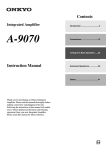
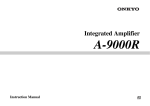
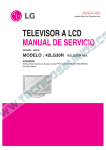
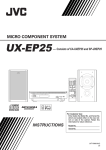
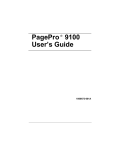
![RD-HA3[E] (GE,FR)](http://vs1.manualzilla.com/store/data/006740309_1-fb2a8ba0a70886a788ac03c949d1a2d0-150x150.png)
